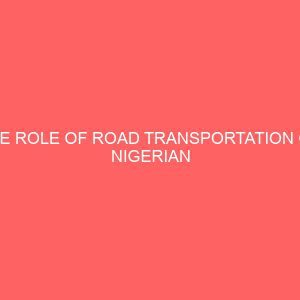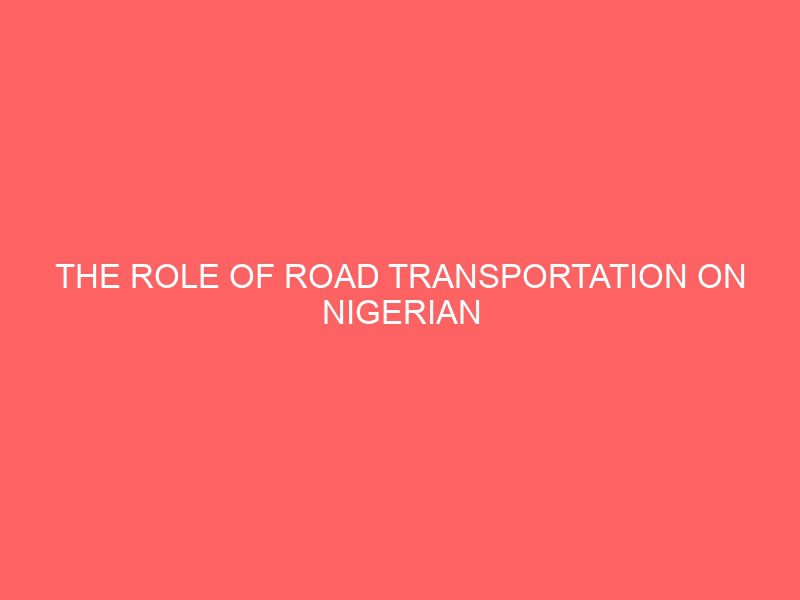Description
CHAPTER ONE
1.0 Introduction
1.1 Background of the Study
In Nigeria, the history of transportation dates to the pre-colonial era when today?s transport such as road, rail, water and air transport were non-existence and only the pedestrian bush path like a jigsaw of small disjoined sections was readily available and gladly used by people to move from one place to another.
Overtime, road transportation system has been widely preferred as the most predominant mode of transport followed by inland waterways and air transport.
By lowering the cost and reducing the time of moving goods and services to where they can be used more efficiently, road development adds value and spurs growth. Over time this process results in increasing the size of markets which is a precondition for realizing economies of scale. Good road projects clearly contribute to poverty reduction by improving the living conditions of people and by augmenting the opportunities available for trade and employment. The economic development of Nigeria has reflected the development of her transport systems. This is particularly true of the road transport system, which is by far the most widely used mode of transport in the country. Of all commodity movements to and from the sea-ports, at least two-thirds are now handled by road transport while up to 90% of all other internal movements of goods and persons take place by roads (Onakomaiya, undated).
Transport can contribute to the economy directly through addition to capital stock via increases in transport infrastructure. Transport provides the arteries through which the economic life of the people, information and raw materials as well as finished products can be moved from one place to the other. This therefore helps to build and maintain the society thereby leading to economic growth. It is in that context that the paper considers road development and economic growth in Nigeria.
Anyanwu et al (1997) documented that the history of road transport in Nigeria dates back to 1904 when Lord Laggard attempted the construction of a mule road linking Zaria and Zungeru both in the Northern States of Nigeria. The road was later extended from Zaria to Sokoto, Katsina and Maiduguri. However, the road linking Ibadan and Oyo constructed in 1906 is recorded to be the first motorable road ever constructed in Nigeria. At independence in 1960, the Nigerian landscape was dotted with a skeletal network of trunk roads as well as secondary and feeders roads that exhibited the characteristics which reflected the purpose of their construction. They were narrow and winding, being simply meant to facilitate the evacuation of agricultural produce from the interior to the ports for exports in addition to serving as links between scattered human settlements thus permitting ease of administration.
In 1925, the central government of Nigeria set up a Road Board. By 1926, H.E. Walker proposed a skeleton trunk road system to link the major administrative centres in the country. These roads were designed as a frame upon which the network of secondary roads could be built thus enabling the general road system to be considered as a co-coordinated whole-rather as a jigsaw of small disjointed sections. The total length of roads maintained by the government rose soon from 6,160 km (5,875 miles) in to 9,453 km (5,875 miles).
Data from the various publications of the Federal Office of Statistics in Nigeria show that as at 1951, out of the total of 44,414 km of road in Nigeria, 1,782 km were surfaced, though the roads were lacking in standard designs and were single lane with sharp bends and poor drainage system. Total road length increased from 44,414 km in 1951 to 114,768 km in 1980. While tarred road increased in length from 1782 km in 1951 to 28632 km in 1980, earth/gravel road increased from 4232 km in 1951 to 86136 km in 1980. The Central Bank of Nigeria (2003) documented that the estimated current total road networks in Nigeria is about 200,000 km.
In Economy, production takes place when goods and services reach the final consumers and it is through transportation of goods and services that it reaches the final consumers.
Moreover, there are some problems/inadequacies in road transportation which handicap or hindering the success of economic activities of Nigeria which include farming activities like movement of farm produce after harvest from farm location to consumption point. Movement of raw materials from extraction point to manufacturing point then to point of usage by consumers and movement of people from their home setting to their working place.
1.2 Statement of the Problem
Given the fact that transportation infrastructure is very crucial to the growth of the economy, the situation of Nigeria transportation infrastructure is at a poor state. Recent studies by Adeniji (2000), Innocent C. Obi (2011) shows that: less than 50% of the National road networks are in fair or good condition causing an average death of 50 people per day.
Recent studies by Adeniji (2000), Innocent C. Obi (2011) shows that: less than 50% of the National road network are in fair or good condition causing an average death of 50 people per day; Less than 300,000 tonnes of freight and less than 2.3 million passenger are been transported by rail; More occurrences of air crashes in the Aviation sector; High rate of congestion in the sea port; and More vandalization of pipeline. When all this losses are added up to economic cost for loss of productive man-hour, it becomes clear that the situation really need urgent attention. However, various research studies have been descriptive showing the importance of having a better transportation infrastructure in place so as to increase the sector contribution to economic growth and development, although there are few study that are empirical. Thus, this study will enlighten us on the situation and empirical linkage of transportation infrastructure improvement and economic growth, in which more emphasis will be on Nigeria transport infrastructure.
1.3 Objectives of the Study
The broad objective of this study is to examine the role of road transportation on Nigerian economic activities. The specific objectives of the study are as follows:
i. To evaluate the empirical linkage between road transportation and economic growth.
ii. To explore the relationship between transportation and distribution of productive inputs for production of goods
iii. To assess the nexus between transportation and distribution of finished products (both agricultural and manufactured).
iv. To examine the impact of transportation on training activities especially in the Ibarapa East Local Government Area of Oyo State.
1.4 Research Question
Based on the background of this research work, the research questions are as follow:
1. Does road transportation have significant impact on the distribution of productive inputs in Nigeria?
2. Does road development adds value and spurs growth during the time of moving goods and services?
3. Does road transportation impact on the delivery of finished products for consumption to consummate production process?
4. Does road transportation and training activities offer means livelihood to Nigerians and the residents of Ibarapa East Local Government Area in Oyo State.
1.5 Scope of the Study
This research work is based on role of road transportation on Nigeria economic activities. A case study of Ibarapa East Local Government, Area Eruwa.
1.6 Limitation of the Study
i. The research consumes a lot of time.
ii. The research was limited due to the financial constraint of the researcher.
1.7 Significance of the Study
The study of the road transportation system in the Nigerian economy is of great importance as the study will create an insight to the value of road transportation in driving economic activities in Nigeria.
Efficiency in the road transportation sector of the Nigeria economy through a reduction of elimination of some vital problems will have a positive effect on the national economy. The constitution of new roads proper, check on vehicle worthiness will to a large extent revive the road transportation sector and in torn boost activities in the economy as the road transport sector is invaluably the backbone of all other sector in every economy. This work also tends to check whether or not revenue from the government has contributed significantly to the development of road transportation system in the Nigeria economy and to update frontier knowledge for other researchers.
1.8 Plans of Study
This project topic consists of five chapters to enlighten us about the roles of road transportation on Nigerian economic activities. The chapter one covers the introduction, statement of the problem, objectives of the study, research question, significance of the study, plans of the study of the study, definition of terms.
The chapter two contains the review of related works, the chapter give the details of the project topic which is ?the role of road transportation in Nigerian economic activities (a case study of Ibarapa East Local Government Area, Eruwa?.
The chapter three deals with the research methodology; research design, sample size and sample procedure, research instrument, validity of the research instrument, reliability of the research instrument, data collection procedure, data analysis techniques.
Chapter four is all about the presentation and analysis of data.
Chapter five contains discussion of findings, recommendations, and areas for further studies and conclusion.
1.9 Operational Definition of Terms
Transportation: Is defined as a particular movement of an organism or thing from a point to another Point.
Resources: An economic or productive factor required accomplishing activity, or as means to undertake an enterprise and achieve desired outcome.
Economy: The state of a country or region in terms of the production and consumption of goods and services and the supply of money.
Society: A society is a group of individuals involved in persistent social interaction, or a large social group sharing the same geographical or social territory, typically subject to the same political authority and dominant cultural expectations.
Transport Infrastructure: refers to the framework that supports our transport system. This includes roads, railways, ports and airports. National and local government is responsible for the development of our transport infrastructure
Effectiveness: It is the capability of producing a desired result or the ability to produce desired output. When something is deemed effective, it means it has an intended or expected outcome, or produces a deep, vivid impression.
Input: What is put in, or operated on by any process or system.
Finished Products: A product which have received the final increments of value through manufacturing or processing operations, and which are being held in inventory for delivery, sale, or use.
Economic Growth: An increase in the amount of goods and services produced per head of the population over a period of time.
1.10 Historical Background of Ibarapa East Local Government Area
The Ibarapa area falls within latitudes 70.15? N and 70.55? N and longitudes 30E and 30.30? E. It is located approximately 100 Km north of the coast of lagos ,and about 95 Km west of the Oyo state capital and neighboring city of Ibadan. They border Yorubas of Onko extraction to the North (Iwajowa, Kajola and Iseyin LGAs) and Yorubas of Oyo extractionto the East (Ibadan). The Yewas or Egbados to the West, and the Egbas to the South.
The area is approximately 2,496 kmý in geographical size, and consists mostly of rolling savannah with forests situated along the southern border and in isolated patches along river courses such as the Ogun. The natural vegetation was originally rainforest but that has been mostly transformed into derived type savanna as a result of several centuries of slash & burn agricultural practices. Most of the land lies at elevations ranging between 120 and 200 meters above sea level, but rocky inselbergs and outcrops can be seen rising to 340 meters (approx 1,115 ft)
Ibarapa land is traditionally made up of 7 principal towns known as the Ibarapa Meje (Ibarapa Seven), and their surrounding villages and farmsteads. These towns include Igangan, Eruwa, Aiyete, Tapa, Idere, Igbo-Ora, and lanlate. Tapa and Aiyete are in Ibarapa North local government area, Idere and Igbo-Ora are in Ibarapa Central, while Lanlate and Eruwa are located in Ibarapa East local government. The three local governments were created by the federal government of Nigeria authorities in 1996 when Ibarapa East was carved out from the old Ibarapa Local Government while Ibarapa Central and North were carved out of the former Ifeloju Local Government area.
The seven principal towns can be subdivided further, based on the villages that are organized around each of them. In totality, about 30 different villages litter the landscape.
?







